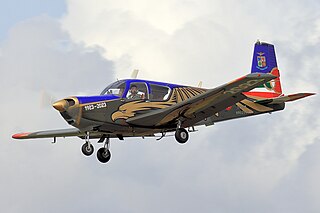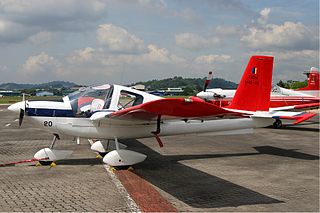
The Cessna 152 is an American two-seat, fixed-tricycle-gear, general aviation airplane, used primarily for flight training and personal use. It was based on the earlier Cessna 150 incorporating a number of minor design changes and a slightly more powerful engine with a longer time between overhaul.

The Beechcraft Travel Air is a twin-engine development of the Beechcraft Bonanza. It was designed to fill the gap between the single engine Model 35 Bonanza and the much larger Model 50 Twin Bonanza, and ultimately served as the basis for its replacement, the Baron.

The Beechcraft Model 50 Twin Bonanza is a small twin-engined aircraft designed by Beechcraft as an executive transport for the business market. It was developed to fill a gap in Beechcraft's product line between the single-engined Model 35 Bonanza and the larger Model 18. The Twin Bonanza is dissimilar to the Bonanza, being much larger and heavier and using more powerful engines, while in its earliest form having only half the passenger capacity of the Model 18.

The Piper PA-38-112 Tomahawk is a two-seat, fixed tricycle gear general aviation airplane, originally designed for flight training, touring and personal use.

The Piper PA-44 Seminole is an American twin-engined light aircraft manufactured by Piper Aircraft.

The Beechcraft Model 76 Duchess is an American twin-engined monoplane built by Beechcraft intended partly as a low cost introduction to twin-engine aircraft.

The Beechcraft Musketeer is a family of single-engined, low-wing, light aircraft that was produced by Beechcraft. The line includes the Model 19 Musketeer Sport, the Model 23 Musketeer, Custom and Sundowner, the Model 23-24 Musketeer Super III, the retractable gear Model 24R Sierra and the military CT-134 Musketeer.

The Cessna T303 Crusader is an American six-place light twin-engined aircraft built by Cessna Aircraft Company. Production ceased in 1986.

The Gulfstream American GA-7 Cougar is an American all-metal, 4-seat, twin-engined light aircraft. The Cougar was a twin-engine development of the Gulfstream American AA-5B Tiger and traces its lineage to the AA-1 Yankee Clipper and the Bede BD-1.

The Cessna 425, known as the Corsair and later as the Conquest I, is an eight-seat American pressurized turboprop twin-engined light aircraft. Now out of production, it was built by Cessna Aircraft of Wichita, Kansas, between 1980 and 1986.

The Cessna 340 is a twin piston engine pressurized business aircraft that was manufactured by Cessna.

The Alpha Aviation Alpha 2000 is a two-seat, all-metal training and general aviation aircraft, designed by Chris Heintz and built in Hamilton, New Zealand. It continues the successful French Apex Aircraft's Robin R2000 series acquired upon Apex's purchase of the Avions Robin company.

The Liberty XL2 is a two-seat, low-wing, general aviation aircraft manufactured from 2004–2011 by Liberty Aerospace of Melbourne, Florida. A derivative of the Europa XS kit plane, it serves both as a touring aircraft for private flyers and as a flight trainer.

The Beechcraft CT-134 Musketeer is a military training derivative of the Musketeer built by Beechcraft for the Canadian Armed Forces. The CT-134 was a single engine, low-wing, four-seat light aircraft with fixed landing gear and a limited aerobatic capability.

The Partenavia P.64B/P.66B Oscar is an Italian two/four-seat, single-engined, high-wing monoplane built by Partenavia.

The SIAI-Marchetti S.205 is an Italian four-seat, single-engine, light airplane, manufactured by SIAI-Marchetti. The S.205 made its maiden flight in 1965. The Italian Air Force employs a version called S.208.

The SME Aero Tiga, originally the Dätwyler MD-3 Swiss Trainer is a trainer aircraft developed in Switzerland through the 1960s and 70s, and which first flew in 1983.

The Fuji T-7 is a Japanese primary trainer aircraft built by Fuji Heavy Industries for the Japan Air Self-Defense Force. A development of Fuji's earlier T-3 trainer, it is a single-engined monoplane powered by a turboprop engine.

The GY-80 Horizon is a French four-seat touring monoplane of the 1960s designed by Yves Gardan and built under licence, first by Sud Aviation, and later by that company's SOCATA subsidiary.
The Mooney 301 was a prototype aircraft created by American manufacturer Mooney Aircraft Company in 1983. It was a low-wing, single-engine, six-place monoplane with retractable landing gear and a pressurized fuselage.





















